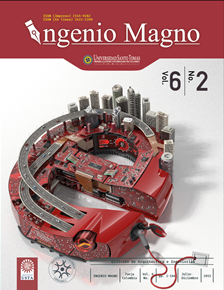Design of a microprocessor for educational purposes
Main Article Content
Abstract
Downloads
Article Details
DECLARATION OF ORGINIALITY OF SUBMITTED ARTICLE
With this document, I/We certify that the article submitted for possible publication in the institutional journal INGENIO MAGNO of the Research Center Alberto Magno CIIAM of the University Santo Tomás, Tunja campus, is entirely of my(our) own writing, and is a product of my(our) direct intellectual contribution to knowledge.
All data and references to completed publications are duly identified with their respective bibliographical entries and in the citations thus highlighted. If any adjustment or correction is needed, I(we) will contact the journal authorities in advance.
Due to that stated above, I(we) declare that the entirety of the submitted material is in accordance with applicable laws regarding intellectual and industrial property, and therefore, I(we) hold myself(ourselves) responsible for any complaint related to it.
If the submitted article is published, I(we) declare that I(we) fully relinquish publishing rights of the article to the University Santo Tomás, Tunja campus. As remuneration for this relinquishment of rights, I(we) declare my(our) agreement to receive two (2) copies of the edition of the journal in which my(our) article appears.
References
Hennessy, J. y Patersson, D. (2007). Computer architecture: A quantitative approach (4.a ed.). San Francisco: Elsevier.
Hincapie, J. y Jaramillo, J. (2011). Diseño e implementación de un microprocesador de propósito específico. Scientia et Technica, 16(47), 136-140.
Hwang, E. (2004). Digital logic and microprocessor design with VHDL. Riverside: Team Electronics.
Mano, M. (1982). Lógica digital y diseño de computadores. Madrid: Prentice Hall.
Mano, M. y Kime, C. (2008). Logic and computer design fundamentals (4.a ed.). Upper Saddle River: Pearson Prentice Hall.
Palacios, E. y Remiro, F. (2006). Microcontrolador PIC16F84A: Desarrollo de proyectos (2.a ed.). Ciudad de México: AlfaOmega.
Pardo, F. y Boluda, J. (1999). Lenguaje para síntesis y modelado de circuitos. Madrid: RA-MA.
Pareja, A. y Vera, M. (2014). Diseño VHDL de una procesado de ocho bits e implementación en un CPLD. Recuperado de http://www.iberchip.net/IX/Articles/ POST-123.pdf
Patersson, D. y Hennessy, J. (2005). Computer organization and design: The hardware/software interface (3.a ed.). San Francisco: Elsevier.
Paul, R. (1994). SPARC Architecture assembly language programming, and C. Nueva Jersey: Prentice Hall.
Sedef, H. (2010). Designing of a 16 - bit microprocessor by using FPGA. National Conference on Electrical, Electronics and Computer Engineering (ELECO), 349- 354.
Stallings, W. (2006). Organización y arquitectura de computadores (7.a ed.). Madrid: Pearson.
Varrientos, J. (1991). VLSI microprocessor design for classroom instruction. University/Government/Industry Microelectronics Symposium, 70-75.
Vrenesic, Z. y Brown, S. (2004). Fundamentals of digital logic with VHDL design. Madrid: McGraw-Hill.

